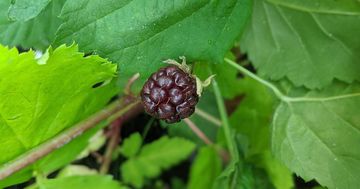Boysenberries


Introduction
Boysenberries are a hybrid berry made from crossing blackberry, raspberry, loganberry, and dewberry. They have an excellent reputation for flavour, with large fruit tasting like a sweet blackberry, combined with the hardiness, disease resistance, and vigour of the other berries.
Boysenberries were developed to combine the vigorous growth of blackberries with the juiciness and sweetness of other berries. Plants can grow up to 2 m high and wide, and produce fruit larger in size that both blackberries and raspberries. The canes are usually thornless.
Watch On YouTube
Planting
- Plant boysenberry plants at the same depth as the pot they were sold in (covering all roots)
- Space at least 2 m apart
Harvesting
- Enjoy fresh (as per blackberries and raspberries)
- Freeze, or turn into cooked desserts, jam, or compot
(inside)
(outside)
(fresh)
(stored)










 = freeze,
= freeze,  = store
= store
Varieties
Typically, shops sell only one type of boysenberry. For variety, you may like to see other types of berry like blackberry, tayberry, loganberry, and raspberry.
The easy way for a gardener to organise their growing and discover gardening ideas.
Growing
Boysenberries are usually trained onto a support like a trellis, archway, or commonly wire strung between poles. The plants grow quite tall and wide, so the support needs to be strong enough to hold the weight of the canes and fruit, and to withstand the plant swaying in the wind when in full leaf.
Boysenberries fruit on one year old canes. All canes that have provided fruit during summer should be cut away, and the new canes that have freshly grown that summer are tied onto support for the start of winter (or latest before early spring in the next growing season).
Newly planted boysenberries can provide fruit in their first year, but will be much more prolific in their second year when the plant has become established and grown fresh canes. Additional boysenberry plants are propagated by burying the tips of canes into compost. When new growth appears above the surface, the old cane can be cut away, and the new plant relocated to its final growing position.

